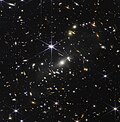This article needs to be updated.(July 2022) |





The James Webb Space Telescope (JWST) is an international 21st-century space observatory that was launched on 25 December 2021. [1] [2] It is intended to be the premier observatory of the 2020s, combining the largest mirror yet on a near-infrared space telescope with a suite of technologically advanced instruments from around the world. [3]
Contents
- Timeline of selected events
- Pre-launch plans
- After-launch
- After-launch deployment
- First images
- References
- External links
The telescope is designed to last at least five and a half years (six months calibration plus five years science operations), but with a goal of ten years. [4] The limiting factor is expected to be fuel to maintain its halo orbit, of which there is enough for at least ten years. [4]
It was announced in December 2021 that due to the accuracy of the orbital insertion and course correction burns, the telescope had more fuel available than originally planned and could operate for "significantly" longer than the original ten year planned life span. [5]
JWST cost approximately $10 billion in its design, construction, and five years of operations (does not include extended mission funding), as well as international contributions. [6] [7]



